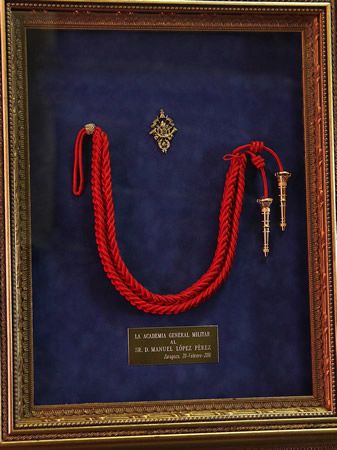- Home
- UNITS
- Zaragoza
- General Military Academy
- Traditions
- Los cordones del cadete
MENÚ UNIDAD
ARMY UNITS
- Araba Álava |
- Albacete |
- Alicante |
- Almería |
- Asturias |
- Ávila |
- Badajoz |
- Barcelona |
- Burgos |
- Cáceres |
- Cádiz |
- Cantabria |
- Castellón |
- Ceuta |
- Ciudad Real |
- Córdoba |
- A Coruña |
- Cuenca |
- Girona |
- Granada |
- Guadalajara |
- Gipuzkoa |
- Huelva |
- Huesca |
- Islas Baleares |
- Jaén |
- León |
- Lleida |
- Lugo |
- Madrid |
- Málaga |
- Melilla |
- Murcia |
- Navarra |
- Ourense |
- Palencia |
- Las Palmas |
- Pontevedra |
- La Rioja |
- Salamanca |
- Segovia |
- Sevilla |
- Soria |
- Tarragona |
- Santa Cruz de Tenerife |
- Teruel |
- Toledo |
- Valencia |
- Valladolid |
- Bizkaia |
- Zamora |
- Zaragoza

Traditions
The cadet's aiguillettes
According to some writers of the 19th century, the origin of the cadet's aiguillettes could be in the wars of Flanders. The Duke of Alba envisaged to hang all the members of a contingent of auxiliary Flemish troops to punish their lack of courage.
These soldiers, resentful of the Duke, hung a rope with a nail to facilitate the execution of the punishment at the moment. The subsequent actions of the unit were courageous and brilliant. Their reaction did not go unnoticed and henceforth the aiguillette was considered an attribute of distinction and notoriety for the unit that wore it.

Cadet's Aiguillettes. (photo: AGM)
In the European armies of the seventeenth century it was part of uniformity as an ornamental detail or to indicate a particular class or condition.
In Spain, the Ordinance of 1762 established the use of aiguillettes in Military Education. In 1875 the name of cadet and the use of aiguillettes were suppressed by Royal Decree.
The reopening of the Academia General Militar in 1927 regained in its Regulations the name of cadet (instead of student) and the use of the current aiguillettes with the design and current color.
Cadets dressed in uniforms of all epochs. (Photo AGM)
The establishment of the Second Republic in 1931 with its reform of the military institution involved, among other measures, the closure of “La General”, although the use of red aiguillettes was maintained in the Academies of all the Corps and Arms.
After the Civil War in 1942 the Academy opened its doors again and its cadets received, like other traditions jealously guarded, this external distinctive sign so characteristic and appreciated.
Over time, the use of aiguillettes using the same design was extended to all cadets in the training period. It changed the color of the aiguillette and so for the cadets in the Basic General Academy of NCOs it was white, for the ones in the Special Military Academy red and white and it was green for those who did the military service in the University Militias.



